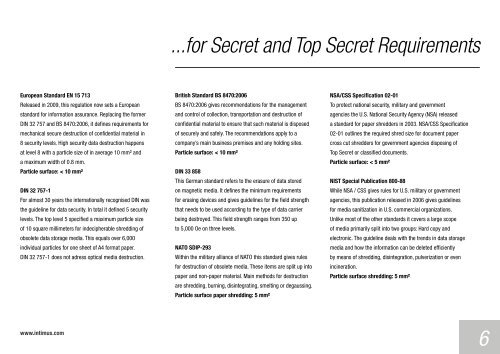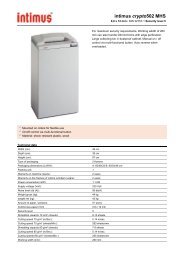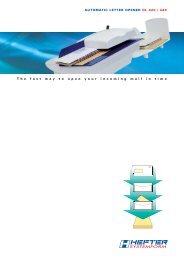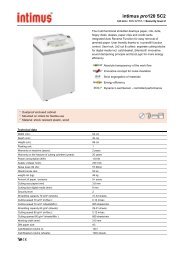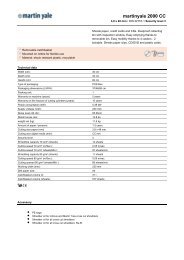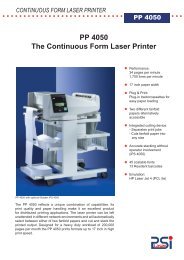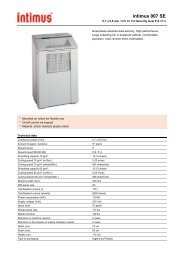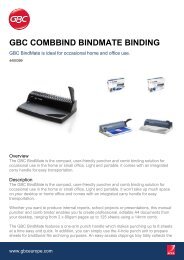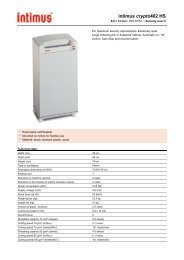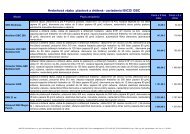Information Security beyond the Endpoint
Information Security beyond the Endpoint
Information Security beyond the Endpoint
Create successful ePaper yourself
Turn your PDF publications into a flip-book with our unique Google optimized e-Paper software.
...for Secret and Top Secret Requirements<br />
European Standard EN 15 713<br />
Released in 2009, this regulation now sets a European<br />
standard for information assurance. Replacing <strong>the</strong> former<br />
DIN 32 757 and BS 8470:2006, it defines requirements for<br />
mechanical secure destruction of confidential material in<br />
8 security levels. High security data destruction happens<br />
at level 8 with a particle size of in average 10 mm² and<br />
a maximum width of 0.8 mm.<br />
Particle surface: < 10 mm²<br />
DIN 32 757-1<br />
For almost 30 years <strong>the</strong> internationally recognised DIN was<br />
<strong>the</strong> guideline for data security. In total it defined 5 security<br />
levels. The top level 5 specified a maximum particle size<br />
of 10 square millimeters for indecipherable shredding of<br />
obsolete data storage media. This equals over 6,000<br />
individual particles for one sheet of A4 format paper.<br />
DIN 32 757-1 does not adress optical media destruction.<br />
British Standard BS 8470:2006<br />
BS 8470:2006 gives recommendations for <strong>the</strong> management<br />
and control of collection, transportation and destruction of<br />
confidential material to ensure that such material is disposed<br />
of securely and safely. The recommendations apply to a<br />
company’s main business premises and any holding sites.<br />
Particle surface: < 10 mm²<br />
DIN 33 858<br />
This German standard refers to <strong>the</strong> erasure of data stored<br />
on magnetic media. It defines <strong>the</strong> minimum requirements<br />
for erasing devices and gives guidelines for <strong>the</strong> field strength<br />
that needs to be used according to <strong>the</strong> type of data carrier<br />
being destroyed. This field strength ranges from 350 up<br />
to 5,000 Oe on three levels.<br />
NATO SDIP-293<br />
Within <strong>the</strong> military alliance of NATO this standard gives rules<br />
for destruction of obsolete media. These items are split up into<br />
paper and non-paper material. Main methods for destruction<br />
are shredding, burning, disintegrating, smelting or degaussing.<br />
Particle surface paper shredding: 5 mm²<br />
NSA/CSS Specification 02-01<br />
To protect national security, military and government<br />
agencies <strong>the</strong> U.S. National <strong>Security</strong> Agency (NSA) released<br />
a standard for paper shredders in 2003. NSA/CSS Specification<br />
02-01 outlines <strong>the</strong> required shred size for document paper<br />
cross cut shredders for government agencies disposing of<br />
Top Secret or classified documents.<br />
Particle surface: < 5 mm²<br />
NIST Special Publication 800-88<br />
While NSA / CSS gives rules for U.S. military or government<br />
agencies, this publication released in 2006 gives guidelines<br />
for media sanitization in U.S. commercial organizations.<br />
Unlike most of <strong>the</strong> o<strong>the</strong>r standards it covers a large scope<br />
of media primarily split into two groups: Hard copy and<br />
electronic. The guideline deals with <strong>the</strong> trends in data storage<br />
media and how <strong>the</strong> information can be deleted efficiently<br />
by means of shredding, disintegration, pulverization or even<br />
incineration.<br />
Particle surface shredding: 5 mm²<br />
www.intimus.com<br />
www.intimus.com<br />
6


